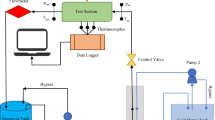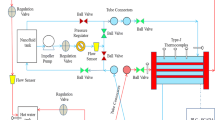Abstract
Hydrothermal and energy-economic performances of minichannel heat sink are experimentally compared by using water-based different nanoparticle-dispersed mono and hybrid nanofluids. Al2O3, AlN, CNT, Cu and capric acid as phase change material (PCM) are considered. Different nanoparticles combinations (oxide–PCM, oxide–nitride, oxide–carbon nanotube and oxide–metal) in 50/50 volume ratio with water (base fluid) are taken as working fluids. The effects of volume flow rate (0.1–0.5 LPM) or Reynolds number (50 to 500) and total particle volume concentration (0.01–0.1%) are investigated. Convective heat transfer coefficient and pressure drop increase by about 42.3% and 22%, respectively, for Al2O3 + CNT nanofluid. The maximum reduction of 26.6% in thermal resistance is obtained for Al2O3 + CNT nanofluid as compared to base fluid. Heat transfer effectiveness and figure of merit are above one for all the hybrid nanofluids, which conclude that hybrid nanofluid is a better option over base fluid for minichannel heat sink. Al2O3 + CNT hybrid nanofluid is better in terms of heat transfer effectiveness, but Al2O3 + AlN hybrid nanofluid yields higher heat transfer coefficient to pressure drop ratio and coefficient of performance. The lower nanoparticle volume concentration in nanofluid is preferable due to higher stability, lower clogging and lower cost per cooling capacity of heat sink.
















Similar content being viewed by others
Abbreviations
- A :
-
Effective heat transfer area (m2)
- c p :
-
Specific heat (J kg−1 K−1)
- d h :
-
Hydraulic diameter (mm)
- f :
-
Friction factor (–)
- P p :
-
Pumping power (W)
- h :
-
Heat transfer coefficient (W m‒2 K−1)
- h ch :
-
Channel height (mm)
- k :
-
Thermal conductivity (W m‒1 K−1)
- \(\dot{V}\) :
-
Volume flow rate (LPM)
- ɛ :
-
Heat transfer effectiveness (–)
- ɛ th :
-
Thermal effectiveness (–)
- R th :
-
Thermal resistance (K W−1)
- Nu:
-
Nusselt number (–)
- Δp :
-
Pressure drop (Pa)
- Pr:
-
Prandtl number (–)
- \(\dot{Q}\) :
-
Heat transfer rate (W)
- Re:
-
Reynolds number (–)
- T :
-
Temperature (°C)
- u :
-
Velocity (m s−1)
- w ch :
-
Channel width (mm)
- L ch :
-
Channel length (mm)
- L :
-
Latent heat of fusion (kJ kg−1)
- C p :
-
Unit cost ($ kWh−1)
- µ :
-
Dynamic viscosity (Pa s)
- ρ :
-
Density (kg m−3)
- φ :
-
Volume concentration (–)
- η :
-
Efficiency (–)
- bf:
-
Base fluid
- nf:
-
Nanofluid
- ch:
-
Channel
- in:
-
Inlet
- out:
-
Outlet
- s:
-
Surface
- m:
-
Mean
- CNT:
-
Carbon nanotube
- FOM:
-
Figure of merit (–)
- PEC:
-
Performance evaluation criteria (–)
- COP:
-
Coefficient of performance (–)
- PCM:
-
Phase change material (–)
References
Ghani IA, Sidik NAC, Kamaruzaman N. Hydrothermal performance of microchannel heat sink: the effect of channel design. Int J Heat Mass Transf. 2017;107:21–44.
Hung TC, Yan WM, Li WP. Analysis of heat transfer characteristics of double-layered microchannel heat sink. Int J Heat Mass Transf. 2012;55:3090–9.
Dewan A, Mahanta P, Raju KS, Kumar PS. Review of passive heat transfer augmentation techniques. Proc Inst Mech Eng Part A J Power Energy. 2004;218:509–27.
Mahian O, Bajestan EE, Poncet S. Nanofluid today. J Therm Anal Calorim. 2017;135:23–8.
Shadloo MS, Mahian O. Recent advances in heat and mass transfer. J Therm Anal Calorim. 2019;135:1611–5.
Yang L, Mao M, Huang J, Ji W. Enhancing the thermal conductivity of SAE 50 engine oil by adding zinc oxide nano-powder: an experimental study. Powder Technol. 2019;356:335–41.
Yang L, Ji W, Zhang Z, Jin X. Thermal conductivity enhancement of water by adding graphene nanosheets: consideration of particle loading and temperature effects. Int Commun Heat Mass Transf. 2019;109:104353.
Yang L, Ji W, Huang J, Xu G. An updated review on the influential parameters on thermal conductivity of nano-fluids. J Mol Liq. 2019;296:111780.
Ho CJ, Chang PC, Yan WM, Amani P. Thermal and hydrodynamic characteristics of divergent rectangular minichannel heat sinks. Int J Heat Mass Transf. 2018;122:264–74.
Bhattad A, Sarkar J, Ghosh P. Improving the performance of refrigeration systems by using nanofluids: a comprehensive review. Renew Sustain Energy Rev. 2018;82(3):3656–69.
Rashidi S, Mahian O, Languri EM. Applications of nanofluids in condensing and evaporating systems. J Therm Anal Calorim. 2018;131:2027–39.
Rashidi S, Karimi N, Mahian O, Esfahani JA. A concise review on the role of nanoparticles upon the productivity of solar desalination systems. J Therm Anal Calorim. 2019;135:1145–59.
Yang L, Huang J, Ji W, Mao M. Investigations of a new combined application of nanofluids in heat recovery and air purification. Powder Technol. 2019. https://doi.org/10.1016/j.powtec.2019.10.053.
Babar H, Ali HM. Towards hybrid nanofluids: preparation, thermophysical properties, applications, and challenges. J Mol Liq. 2019;281:598–633.
Kumar V, Sarkar J. Research and development on composite nanofluids as next-generation heat transfer medium. J Therm Anal Calorim. 2019;137:1133–54.
Hung TC, Yan WM, Wang XD, Chang CY. Heat transfer enhancement in microchannel heat sinks using nanofluids. Int J Heat Mass Transf. 2012;55:2559–70.
Malvandi A, Zamani M, Hosseini SJ, Moshizi SA. Figure of merit for optimization of nanofluid flow in circular microchannel by adapting nanoparticle migration. Appl Therm Eng. 2017;118:328–38.
Nakharintr L, Naphon P, Wiriyasart S. Effect of jet-plate spacing to jet diameter ratios on nanofluids heat transfer in a mini-channel heat sink. Int J Heat Mass Transf. 2018;116:352–61.
Ho CJ, Liao JC, Li CH, Yan WM, Amani M. Experimental study of cooling performance of water-based alumina nanofluid in a minichannel heat sink with MEPCM layer embedded in its ceiling. Int Commun Heat Mass Transf. 2019;103:1–6.
Liang G, Mudawar I. Review of single-phase and two-phase nanofluid heat transfer in macro-channels and micro-channels. Int J Heat Mass Transf. 2019;136:324–54.
Yang L, Du K, Zhang Z. Heat transfer and flow optimization of a novel sinusoidal minitube filled with non-Newtonian SiC/EG-water nanofluids. Int J Mech Sci. 2020;168:105310.
Selvakumar P, Suresh S. Use of Al2O3–Cu/water hybrid nanofluid in an electronic heat sink. IEEE Trans Compon Packag Manuf Technol. 2012;2:1600–7.
Ho CJ, Chen WC, Yan WM. Experiment on thermal performance of water-based suspensionsof Al2O3 nanoparticles and MEPCM particles in a minichannel heat sink. Int J Heat Mass Transf. 2014;69:276–84.
Ho CJ, Chen WC, Yan WM. Correlations of heat transfer effectiveness in a minichannel heat sink with water-based suspensions of Al2O3 nanoparticles and/or MEPCM particles. Int J Heat Mass Transf. 2014;69:293–9.
Ahammed N, Asirvatham LG, Wongwises S. Entropy generation analysis of graphene–alumina hybrid nanofluid in multiport minichannel heat exchanger coupled with thermoelectric cooler. Int J Heat Mass Transf. 2016;103:1084–97.
Nimmagadda R, Venkatasubbaiah K. Experimental and multiphase analysis of nanofluids on the conjugate performance of micro-channel at low Reynolds numbers. Heat Mass Transf. 2017;53:2099–115.
Ho CJ, Chen WC, Yan WM, Amani P. Contribution of hybrid Al2O3-water nanofluid and PCM suspension to augment thermal performance of coolant in a minichannel heat sink. Int J Heat Mass Transf. 2018;122:651–9.
Nimmagadda R, Venkatasubbaiah K. Two-phase analysis on the conjugate heat transfer performance of microchannel with Cu, Al, SWCNT, and hybrid nanofluids. J Therm Sci Eng Appl. 2017;9:041011.
Bahiraei M, Berahmand M, Shahsavar A. Irreversibility analysis for flow of a non-Newtonian hybrid nanofluid containing coated CNT/Fe3O4 nanoparticles in a minichannel heat exchanger. Appl Therm Eng. 2017;125:1083–93.
Mashayekhi R, Khodabandeh E, Akbari OA, Toghraie D, Bahiraei M, Gholami M. CFD analysis of thermal and hydrodynamic characteristics of hybrid nanofluid in a new designed sinusoidal double-layered microchannel heat sink. J Therm Anal Calorim. 2018;134:2305–15.
Kumar V, Sarkar J. Numerical and experimental investigations on heat transfer and pressure drop characteristics of Al2O3-TiO2 hybrid nanofluid in minichannel heat sink with different mixture ratio. Powder Technol. 2019;345:717–27.
Kumar V, Sarkar J. Experimental hydrothermal behavior of hybrid nanofluid for various particle ratios and comparison with other fluids in minichannel heat sink. Int Commun Heat Mass Transf. 2019;110:104397.
Bhattad A, Sarkar J, Ghosh P. Hydrothermal performance of different alumina hybrid nanofluid types in plate heat exchanger: experimental study. J Therm Anal Calorim. 2019. https://doi.org/10.1007/s10973-019-08682-y.
Ho CJ, Chen WC. An experimental study on thermal performance of Al2O3/water nanofluid in a minichannel heat sink. Appl Therm Eng. 2013;50:516–22.
Kline SJ, McClintock FA. Describing uncertainties in single-sample experiments. Mech Eng. 1953;75:3–8.
Kosar A. Exergo-economic analysis of micro pin fin heat sinks. Int J Energy Res. 2011;35:1004–13.
Author information
Authors and Affiliations
Corresponding author
Additional information
Publisher's Note
Springer Nature remains neutral with regard to jurisdictional claims in published maps and institutional affiliations.
Rights and permissions
About this article
Cite this article
Kumar, V., Sarkar, J. Effect of different nanoparticle-dispersed nanofluids on hydrothermal-economic performance of minichannel heat sink. J Therm Anal Calorim 141, 1477–1488 (2020). https://doi.org/10.1007/s10973-019-09145-0
Received:
Accepted:
Published:
Issue Date:
DOI: https://doi.org/10.1007/s10973-019-09145-0




